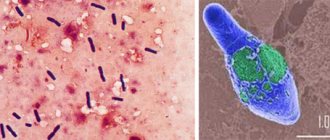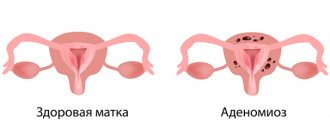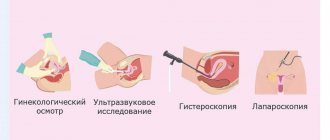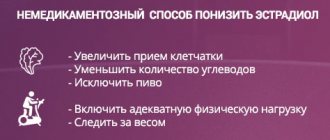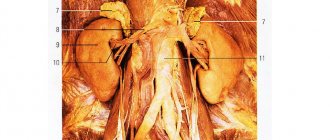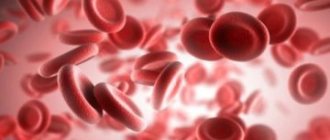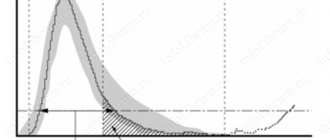Features of thyroid formations
The very first stage in diagnosing nodules and cystic neoplasms in the thyroid gland is a sonographic examination - the use of an ultrasound machine. When a single node is identified in the thyroid gland, the next stage of diagnosis will be a fine-needle biopsy. To determine the functioning of the thyroid gland and endocrine system, the patient undergoes laboratory tests, which consist of determining the level of hormones: thyroxine, tyrosine and thyroid-stimulating hormone.
Cystic neoplasms in the thyroid gland with a diameter of less than one centimeter are amenable to dynamic observation and are removed when their size increases rapidly. Therapeutic therapy for cysts begins with their emptying using a puncture. A benign cyst of the thyroid gland that does not contain inflammatory processes can be re-punctured in case of recurrence. For the removal of a benign thyroid cyst, indications will be its increased size, impact on the organs of the neck, and rapid relapses of fluid accumulation after puncture evacuation. In more common cases, when a thyroid cyst is detected, a hemistrumectomy (hemithyroidectomy) is prescribed - excision of only a lobe of the thyroid gland. If a benign nature of the nodes is detected in two lobes of the gland, a subtotal strumectomy of both sides is performed.
What to do if anechoic areas are found
Treatment methods depend on the cause of the formation of false or true cysts in the gland. Depending on the indications, treatment is carried out conservatively or surgically.
Methods for eliminating anechoic inclusions in the thyroid gland depend on the form of the pathology. For hypertrophy (enlargement) of the gland, treatment with radioactive iodine is indicated. To reduce thyroid formations in nodular goiter, suppressive therapy with iodine-containing hormones - Levothyroxine, L-Thyronine, Bagotyrox - is used.
The operation is performed for malignant cysts and compression syndrome – compression of surrounding organs.
The extent of surgical intervention depends on the diameter of the formations in the gland:
- enucleation – removal of pathological inclusions with maximum preservation of normal tissue;
- hemithyroidectomy - excision of only one thyroid lobe with an isthmus;
- subtotal thyroidectomy - cutting out most of the thyroid gland, leaving only 6 g of functional tissue;
- total thyroidectomy - removal of both lobes of the organ along with the isthmus.
For cystic formations, minimally invasive techniques are recommended, for example, puncture removal of fluid. To prevent the re-formation of anechoic structures in the gland, a sclerosant is injected into the empty capsule of the cyst. It glues the walls together, which prevents the re-accumulation of fluid.
Anechoic inclusions of the thyroid gland are cavity formations with fluid that do not reflect ultrasound. Most often they are represented by true or false cysts with serous or colloidal secretion. Features of therapy depend on the cause of structural changes in the gland. For small cysts, dynamic observation is indicated. But if they impair breathing or deform the neck, they resort to surgical techniques.
Stages of development of thyroid cysts and nodules
The stages of formation of thyroid nodules differ from each other. They differ in the course and stage of development, which is determined by referring to the degree of their echogenicity during ultrasound:
- isoechoic homogeneous node - characterized by a density similar to the tissue surrounding the organ, but the edges are characterized by increased blood circulation and the proliferation of a network of blood vessels;
- the inechogenic stage is characterized by increased blood circulation and an increase in the network of vessels around the node;
- isoechoic heterogeneous node - with this formation, a number of tissue changes are detected in the middle of the capsule of the node. Such changes can be either single and insignificant, or may contain areas of cystic degeneration; in the middle of the node, a small cyst is detected with a certain level of liquid content in it; it can be with small tissue changes or with fairly obvious tissue changes, that is, with areas of cystic degeneration . Isoechogenic heterogeneous nodes are formed as thyroid cells and follicles die;
- a non-echoic (hypoechoic) node can only be detected if the healthy tissue of the gland in such a section of the organs is completely deformed, and in the middle of the formed compacted cyst there is a large number of dead cells and liquid matter. Only in this case is it possible to identify a standard thyroid cyst;
- hypoanechoic or anechoic node: manifested by the destruction of the tissue of the node, the release of fluid and deformed cells in the cavity, this provokes the formation of a thyroid cyst;
- the process of resorption of the substance in the cyst;
- stage of scarring of the cyst by the gland.
The formation of a node in stages takes quite a long time; this time directly depends on the diameter of the nodes, the working processes of the immune system, the state of the balancing functions of the thyroid gland and the body as a whole. For a faster scarring process, sclerosis is often used.
Identification of isoechoic nodes
The thyroid gland is a very sensitive organ to both the environment and everything that happens in the human body. For this reason, over time it is susceptible to the appearance of various neoplasms.
Diagnosis of the problem begins with palpation by an endocrinologist. Palpation makes it possible to identify the size, approximate density of the formation, as well as the localization of the nodes and their mobility.
Next, ultrasound diagnostics is carried out, which helps to determine with a sufficient degree of accuracy the location, density, volume and other necessary data about the isoechoic neoplasm. The development of pathology is of a different nature - focal or diffuse. The focal process refers to the development of a node with clearly defined boundaries. The diffuse process indicates a general change in the entire structure of the gland.
Echogenicity is a measure of the strength of the reflected ultrasound signal during ultrasound, demonstrating the density of the organ. The following types of echogenicity are distinguished.
- Hyperechogenicity. Hyperechoic nodes appear on ultrasound as light spots and have a dense structure. Ultrasound does not pass through such formations.
- Isoechogenicity. An isoechoic homogeneous thyroid nodule is the least risky of all types of neoplasms. It has the same density as the structure of the gland and appears grayish on ultrasound.
- Hypoechogenicity. A hypoechoic formation on ultrasound appears as a spot of a darker color than the adjacent organ tissue. The signal is reflected weakly. Most often, cystic formations are shown in this way. Hypoechoic nodes are not cancerous.
- Anechoic. Complete absence of echogenicity. The signal is not reflected from the gland tissue. This indicates the presence of anechoic formations of the thyroid gland. Anechoicity can appear in normal organ tissue if it is caused by blood vessels as a result of impaired blood flow. The anechoic border of focal formations of the thyroid gland, where the system of blood vessels is located, is usually called halo (halo).
Ultrasound is not always able to determine oncology, so there is a need for more accurate and in-depth examinations.
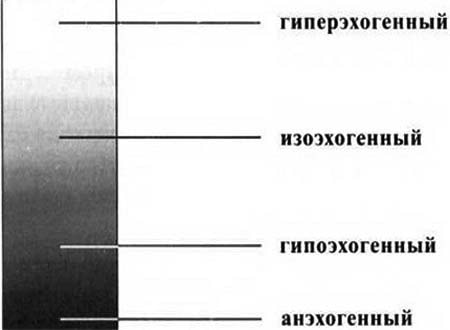
If ultrasound reveals an isoechoic thyroid nodule with a hypoechoic rim or other focal changes, a further, more in-depth examination is prescribed. Diagnosis is carried out through a biopsy (puncture) and cytological examination of the material taken. This makes it possible to determine the cytomorphological structure of the modified tissue.
In order to identify the presence of problems in the functioning of the gland, scintigraphy is sometimes performed. Scintigraphy involves injecting a contrast liquid into a vein or swallowing a capsule and then monitoring its radiation. It is performed when numerous isoechoic formations of the thyroid gland are detected on ultrasound. This research method is considered safe, but has only one contraindication - pregnancy.
Radiation exposure during the examination is insignificant, therefore, it is possible to perform the procedure multiple times in a short period of time.
The following are also used for diagnosis:
- Magnetic resonance imaging. MRI is a highly accurate radiation diagnostic method that provides a three-dimensional and layer-by-layer image of the gland with high contrast. MRI can detect the smallest formations and possible metastases.
- Hormone analysis. Blood tests show hormone levels and abnormalities.
- Laryngoscopy and bronchoscopy. Prescribed for signs of compression of the larynx and trachea.
Only a combination of various examinations can provide an accurate diagnosis.

After completing all studies and tests, the doctor chooses a treatment that is appropriate to the specific situation. The doctor can also limit himself to prevention and observation in cases where the formations are not significant and their nature does not negatively affect overall well-being.
Symptoms of thyroid nodules
Quite often, nodular neoplasms in the thyroid gland develop over a long period of time without visible symptoms, without causing any particular manifestations. Nodules are often painless and small enough that they do not cause discomfort or pressure in the neck area. Such nodes are often discovered by chance during a routine inspection.
To the touch, the nodes are defined as smooth and dense formations. Compared to nodes, normal gland tissue consists of a standard consistency. As a rule, during self-examination, the patient can feel nodes that are already clearly visible and distort the outline of the neck; such nodules are already more than three centimeters in diameter and cannot be treated conservatively. It is better not to allow this situation to happen.
As the nodular formation increases, which leads to compression in the throat area, various complaints are formed:
- sensation of a foreign object and dryness in the throat;
- deterioration of swallowing and breathing;
- hoarseness or complete loss of voice;
- pain in the neck.
Cysts are enlarged and can put pressure on blood vessels. When malignant nodular formations form, the cervical lymph nodes become enlarged.
Autonomous toxic nodes, as a result of their increased activity, lead to the formation of hyperthyroidism with the following symptoms: tachycardia, a feeling of increased heartbeat, flushes of heat waves in the body, agitation, exophthalmos.
A solitary node localized in healthy thyroid tissue is the most suspicious for malignancy, in contrast to other multiple nodes, which often provoke the formation of a diffuse nodular goiter. Malignant nodes are characterized by a rapid increase in size, they have a hard consistency and are mainly accompanied by enlarged lymph nodes in the neck. But still, in the early stages, distinguishing a benign node from a malignant one based on external characteristics is quite problematic.
The essence of anechoicity
Ultrasound (sonography) of the thyroid gland is a non-invasive research method during which you can see:
- organ localization;
- structure and size of the gland;
- the presence of pathological formations;
- anatomical features.
Based on the results of hardware diagnostics, many endocrine diseases caused by gland dysfunction are identified. Ultrasound is performed if there is a suspicion of low-quality tumors, cysts, hypoplasia (underdevelopment) of the gland, adenoma, hormonally active formations, etc.
Echogenicity is a key ultrasound characteristic that is used to describe visual objects. The organs of the human body hinder the propagation of ultrasonic waves in different ways. They have different acoustic impedance, which depends on:
- tissue density;
- speed of propagation of ultrasonic waves.
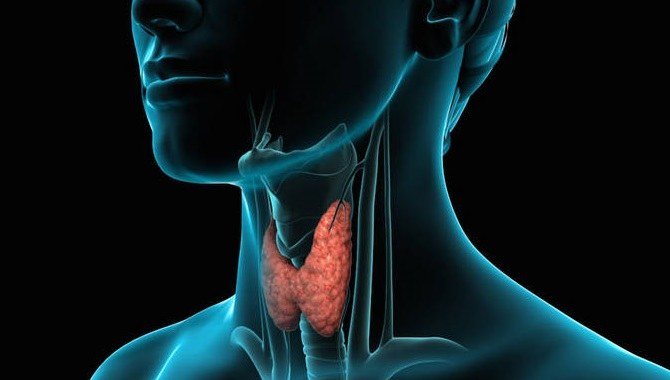
During sonography of the thyroid gland, the doctor identifies areas of 4 types of echogenicity:
- hypoechoic;
- hyperechoic;
- isoechoic;
- anechoic.
Hyperechoic formations contain virtually no fluid, so they have a high acoustic density. Such inclusions have low sound conductivity. Ultrasound is reflected from them as much as possible. They are rendered on the screen as white objects.
Anechoic formations in the thyroid gland are characterized by high sound conductivity. They absorb ultrasonic waves, so they look like black spots. In the unchanged gland, sound-absorbing tubular elements are often found - thyroid vessels, which provide blood supply to the organ. They are called vascular structures. Normally, they are determined in the region of the lower thirds of the thyroid lobes. The number and size of vascular formations depend on the individual structural features of the gland.
Echography resolution:
- the speed of propagation of the ultrasound wave in the thyroid lobes is 1540 m/s;
- the average wavelength with a frequency of up to 7.5 MHz is 210 µm;
- The resolution of the ultrasound sensor (the distance between 2 formations at which it is possible to distinguish them) corresponds to the resolution of the eye and is 200 microns.

Liquid (anechoic) formations in the gland are visualized in cases where their size exceeds the wavelength of 200 microns. If a sonologist detects an avascular formation in the thyroid gland, this indicates a pathological change in the structure of the organ.
Acquired anechoic formations are characterized by hydrophilicity. They consist of a semi-liquid or liquid secretion that absorbs ultrasonic waves.
Diagnosis of thyroid nodules
The main diagnostic method remains visualization using an ultrasound machine. Using ultrasound, you can determine the size of the formation, the structural condition of the cyst and healthy tissue in the area. This study has high diagnostic accuracy; it can also be used to carry out differential diagnosis with adenoma, nodular goiter and other diseases.
A cyst biopsy is prescribed in order to find out the type of cyst and exclude the presence of its malignant nature. During the biopsy, a thin needle is used, which is launched into the cyst while being monitored by an ultrasound machine. This procedure is quite simple and is performed using local anesthesia. For the most accurate diagnosis, test samples are taken from two or three areas of the cyst or from different cysts. There are several characteristics for the contents of a cyst obtained as a result of a biopsy: a yellowish, purple or purplish hue of the substance in the cyst indicates an uncomplicated course. Detection of purulent contents in the cyst is characterized by the presence of inflammatory processes. The collected particles of the test subject can be analyzed microscopically to identify cancer cells. A thyroid cyst is characterized by a tumor-like formation of unchanged glandular cells.
Scintigraphy is another method for diagnosing cystic thyroid nodules. The scintigraphy method involves scanning the thyroid gland after consuming radioactive iodine preparations.
The thyroid gland, accumulating radioactive iodine in its tissues, shows nodules of a different nature:
- warm nodes that absorb the same amount of radioiodine as non-nodular gland tissue are called functioning nodes;
- hot nodes absorb more radioiodine, unlike the surrounding thyroid tissue, they are called autonomously functioning nodes;
- cold nodes do not absorb radioactive iodine, the substance is distributed in healthy tissues of the thyroid gland. Cold nodules may be thyroid cancer.
For enlarged forms of nodes or cystic formations of the thyroid gland, as well as for their malignant manifestation, computed tomography is prescribed.
If there is a feeling of compression of the cervical organs, laryngoscopy is performed - examination of the vocal cords and larynx, as well as bronchoscopy - examination of the trachea.
Magnetic resonance imaging is also used to diagnose thyroid pathologies.
When using X-ray equipment for thyroid nodules and cysts, pneumography of the thyroid gland is used to determine the proliferation of surrounding tissues, as well as angiography to record a violation of the vascular network, fluoroscopy of the esophagus with barium and radiography of the trachea to determine the growth or pressure of the tumor.
Nodules in the thyroid gland (what they are, which are dangerous, which are not, what to do next with them
Problems with the thyroid gland are quite common. According to WHO, about 700 million people in the world suffer from various thyroid diseases. And every year this number increases by 5%. That is, almost everyone has friends or relatives around them who have encountered this. This disease mainly worries women.
What is the thyroid gland?
This is a small soft organ (weighing 25-40 g) which is located on the front surface of the neck and lies on the rings of the trachea. The gland is so named because it is located in front of the thyroid cartilage of the larynx. It has two lobes (left and right), which are connected to each other by an isthmus.
What is she responsible for ? The thyroid gland has a huge impact on the functioning of all organs. Lack or excess of thyroid hormone production manifests itself differently in everyone, depending on which organ in a person is more vulnerable.
Possible signs of decreased thyroid hormones:
- You're freezing for no reason. You wear warm clothes even when it’s hot outside, and in the summer you sleep under a warm blanket.
- Drowsiness. You have a hard time waking up in the morning, and during the day you feel sleepy.
- Increased moisture or dry skin.
- Swelling of the face appeared.
- Hair splits and falls out.
- Hoarseness of voice.
- In women - problems with the menstrual cycle, decreased libido, infertility.
- Frequent constipation, gallstones, enlarged tongue with teeth marks.
- Anemia, high cholesterol.
- Depression and apathy.
- Poor concentration and memory problems.
When hormone production increases, metabolism accelerates significantly. Accordingly, all organs begin to work at an accelerated pace and “wear out” faster. This primarily affects the heart and nervous system.
Signs of increased hormone levels:
- Accelerated metabolism. Weight loss with good appetite.
- Periodic increase in temperature for no apparent reason.
- Excessive excitability of the nervous system, increased heart rate, irritability, insomnia.
- Trembling in hands.
- Increased blood pressure.
- Abdominal pain for no apparent reason, diarrhea and constipation.
- Increased sweating.
The function of the thyroid gland is to produce hormones that regulate metabolism.
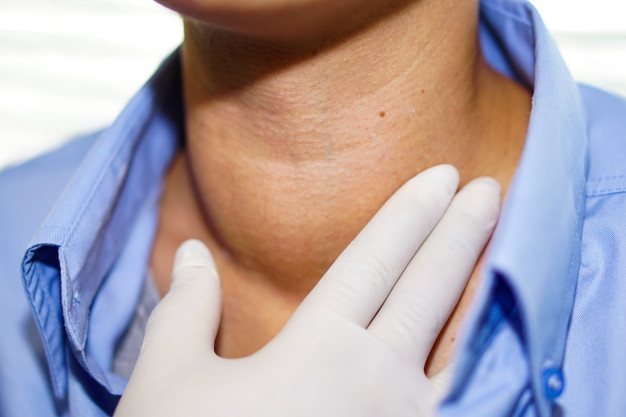
Common thyroid diseases:
- Nodular goiter is the formation of local tissue in the thyroid gland. Depending on the number of nodes, a single-nodular or multinodular goiter is distinguished.
- “Node” or nodular formation - this includes benign and malignant formations.
The danger is that the nodule may not manifest itself at all and the symptoms are also not always present in diseases of the thyroid gland; accordingly, a person may simply not be aware of the existing disease. If the node is small, then only the doctor will see it on an ultrasound, and if the lymph nodes are enlarged and put pressure on other organs located in the neck, then the patient himself will see it.
In most cases, nodes are not a tumor and do not pose any danger to humans, but if a patient has one, it is important to understand whether this formation is benign or not. If atypical cells are found in the puncture of the node, then surgery is indicated.
- Diffuse toxic goiter is the production of antibodies in the body, the excess of which causes poisoning of the entire functioning of the organs. This disease is characterized by weight loss, irritability, insomnia, absent-mindedness, tachycardia
- Chronic autoimmune thyroiditis is the slow destruction of thyroid tissue and its replacement with connective tissue.
- Thyroid cancer or malignancy is found in 5% of patients with thyroid disease. It is important to note that the sooner a node is identified, the sooner a needle biopsy of the tissue must be performed. Despite the shocking figures on the fatal outcomes of various forms of cancer, thyroid cancer is highly treatable.
Malignant formations – thyroid cancer. During the examination, much attention is paid to single nodes. Solitary (single) formations are often malignant . When identifying such nodes, doctors strive to conduct the most complete diagnosis. There is no time to hesitate here.
Causes of knots:
- Iodine deficiency
- Impact of ionizing radiation on the body
- Poisoning
- Genetic predisposition.

In order to determine how your thyroid gland is working, you need to donate blood for thyroid hormones (TSH, etc.).
In order to understand the nature of the cellular composition of the “nodule,” in some cases, a fine-needle aspiration biopsy (FNA) of the thyroid gland is indicated.
What is TAB? This is the most modern method of obtaining diagnostic material by puncturing a suspicious tumor in the thyroid gland area. Aspiration biopsy is performed under ultrasound guidance using a regular 5 ml or 10 ml syringe with a standard needle. The injection causes virtually no pain and takes about 1-2 minutes. Most often, after the first attempt, the doctor makes an accurate diagnosis and prescribes treatment.
If your thyroid nodules and TSH are normal, then everything is fine.
Be sure to monitor the dynamics of node growth once a year.
If you suspect that you have any problems with the thyroid gland or your lymph nodes are enlarged, do not delay, make an appointment with an endocrinologist.
Make an appointment with an endocrinologist
Complications of cysts and thyroid nodules
A thyroid cyst is characterized by the occurrence of an inflamed process and purulent contents in it. As the cyst develops, it can cause complications in the form of inflammation, the formation of hemorrhage in the middle of the cyst, and the transformation of the cyst into a malignant tumor.
Against the background of this inflammation, a painful sensation appears in the heart area, an increase in body temperature to forty degrees, an increase in size and inflammation of the lymph nodes, as well as general intoxication of the body.
Enlarged thyroid nodules and cysts can cause a sensation of compression of neighboring organs and cervical vessels.
Treatment of thyroid cysts and nodules
A patient with nodular and cystic formations is prescribed a specific treatment, the system of which completely depends on the presence of pathology in the tissues of the organ, its size and the age of the patient.
If several nodes are detected at once, the diameter of which is less than one centimeter, patient management with dynamic observation is prescribed; medical manipulations and the use of medications are not used. Only if a single small node is identified is it possible to observe a doctor, visit an endocrinologist every three months and conduct laboratory tests.
The method of treating a cyst is determined by referring to the size and dynamics of the processes - cysts of increased size, as well as formations that are soon filled with collodion again after puncturing, can only be treated surgically.
Monitoring small cysts
Small cysts after the introduction of a solution of sclerosants into them can be treated in the future using a conservative method - an endocrinologist in this situation may prescribe the use of iodine preparations and thyroid hormones. The patient must also undergo monitoring of the condition every month and once a trimester undergo an examination of the neck organs using an ultrasound machine. When such observations are made, a sharp increase in the level of hormones or antibodies in the blood will require immediate action. It will be necessary to quickly abandon further therapy and examination of the patient, the effect of which is to prevent the development of autoimmune thyroiditis. If, upon examination of the puncture, purulent contents of the thyroid gland or part thereof are revealed, then the use of antibiotics and detoxification therapy will be mandatory as part of the treatment. Also, based on the results of microbiological and bacteriological examination of the obtained biopsy, careful selection of drugs will be required.
Surgery
Removal of the cyst will be required if the formation grows rapidly and already exceeds the size of one centimeter, which leads to pressure on the organs of the neck. In such situations, a hemistrumectomy is performed - removal of one lobe of the thyroid gland. The function of the gland when using such an operation is mainly preserved. If a cyst is detected in both lobes, a bilateral subtotal strumectomy is prescribed - complete excision of the gland.
If a malignant nature of the formation is detected, a total strumectomy will be required. During the operation, the entire gland is removed along with fatty tissue and lymph nodes. The operation is quite traumatic, but necessary to completely remove cancer cells. The most common consequence of strumectomy is functional impairment of the vocal cords. After surgery, the patient is required to take thyroid hormones. In addition, calcium supplements must be prescribed, since total resection also removes the parathyroid glands.
In all other cases, surgery is a method that allows the patient not to experience all further symptoms of the disease and avoid complications. If the disease is benign, partial resection of the thyroid tissue is performed; this does not disrupt the hormonal levels of the patient’s body.
Symptoms
In the initial stages, an isoechoic neoplasm does not affect the production of thyroid hormones. All functions of the organ remain within normal limits, therefore, until a certain stage of development, the disease may not manifest itself in any way. However, as it grows, when the node begins to compress the esophagus, trachea and vocal cords, patients develop the following symptoms:
- difficulty breathing, shortness of breath;
- “lump” in the throat;
- painful sensations when swallowing;
- increased heart rate;
- hoarseness of voice.
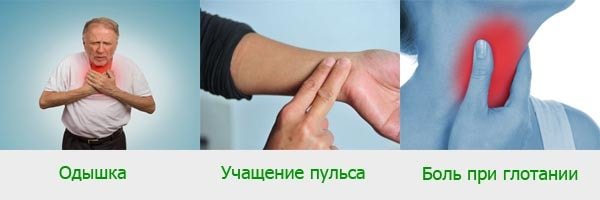
Symptoms depend both on the size of the isoechoic formation and on its location. The stronger the growth, the greater the manifestation of symptoms. In the later stages of the disease, damaged areas of thyroid tissue begin to intensively synthesize hormones, and signs of thyrotoxicosis are observed:
- rapid fatigue;
- increased sweating;
- tremor of the limbs;
- sudden weight loss;
- nervousness;
- rapid heartbeat (tachycardia).
Prognosis for thyroid nodules
Depending on the histological structure of the neoplasm, the prognosis for thyroid nodules and cysts will vary from negative to positive. Benign nodes provide good indicators for complete recovery, in contrast to cystic formations, in which recurrent disease and pathological process quite often occur. When a tumor develops a malignant nature, the prognosis is formed referring to the tumor and its metastasis throughout the body. Detection of the disease in the early stages and removal of tumors predict a complete recovery, but with advanced adenocarcinoma, the disease often ends in death. Thyroid cysts can also recur.
The therapeutic course of moderately malignant formations, without cell screening, is often successfully completed.
Prevention of thyroid nodules
To prevent the formation of nodules and cysts, you will need to consume iodine daily within the age-related physiological norm. The menu will need to include vitamins and foods containing iodine; it is also useful to eat iodized salt. Also an integral part of preventing the formation of thyroid nodules and cysts will be avoiding insolation and avoiding radiation. Physical procedures on the neck area also have a positive effect.
After treatment for a thyroid cyst, follow-up ultrasound scans will be required once a year. Patients with small nodules and cysts of the thyroid gland are required to be registered and undergo dynamic observation by an endocrinologist.
Prevention of focal formations
To prevent various thyroid diseases, experts recommend following a certain diet. The diet must contain a sufficient amount of iodine for the body. Foods containing large amounts of iodine include:
- seaweed;
- various seafood;
- cranberries, black currants, strawberries;
- prunes;
- persimmon;
- garlic, sorrel, spinach;
- buckwheat
However, it must be remembered that iodine is poorly stored and quickly disappears during thermal, chemical and other treatments.



